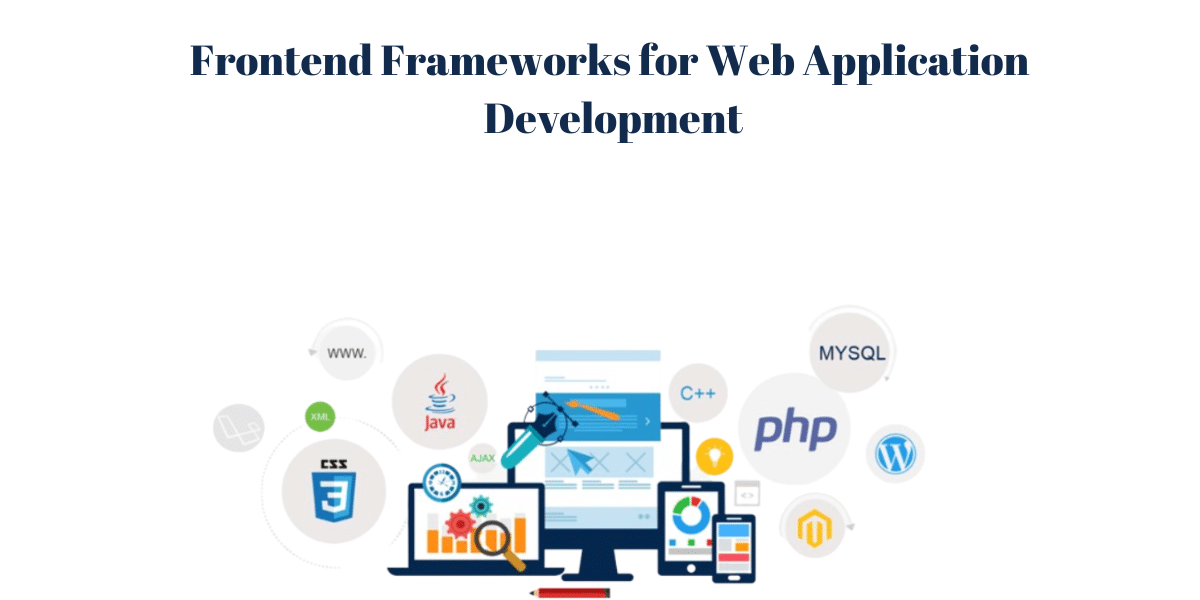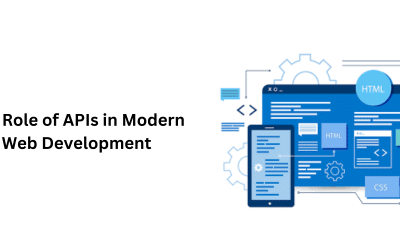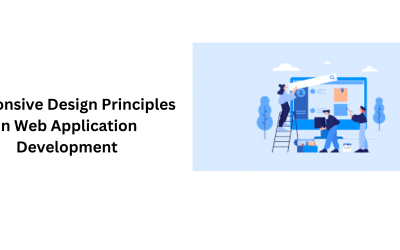In the dynamic realm of web development, the frontend serves as the interface through which users interact with digital experiences. As technology rapidly evolves, so does the landscape of frontend frameworks, shaping the way web application development are designed, developed, and experienced. The advent of Progressive Web Apps (PWAs) and the growing influence of WebAssembly (Wasm) underscore the commitment to delivering faster, more seamless, and feature-rich user experiences.
Server-Side Rendering (SSR), micro-frontends, and the rise of low-code platforms emphasize the importance of scalability, modularity, and inclusivity in modern web development. Additionally, the integration of Artificial Intelligence (AI) and considerations for sustainability point towards a future where frontend frameworks not only prioritize intelligent and personalized user interactions but also eco-friendly practices.
In this ever-evolving landscape, exploring the future trends in frontend development unveils a tapestry of innovation, efficiency, and user-centric design principles that promise to redefine the way we engage with the digital world.
Importance of Choosing the Right Framework
Choosing the right frontend framework is a pivotal decision in web application development, as it profoundly influences the project’s success, scalability, and long-term maintenance. The importance lies in aligning the framework’s features and characteristics with the specific needs and goals of the development project.
A well-suited framework enhances productivity by providing a structured environment, facilitating code organization, and reducing the need for repetitive tasks. It dictates the overall architecture, which directly impacts the application’s performance, user experience, and responsiveness. The right framework ensures compatibility with emerging technologies and industry standards, allowing developers to adopt modern practices and seamlessly integrate new features.
Additionally, it plays a crucial role in the project’s maintainability, as a robust and well-supported framework simplifies debugging, updates, and collaboration among development teams. The chosen framework also affects the learning curve for developers, influencing how quickly they can adapt and contribute to the project.
Moreover, frameworks contribute to the overall security of the application by providing built-in measures and best practices, mitigating common vulnerabilities. In essence, the decision to choose the right frontend framework is strategic, impacting development efficiency, application performance, adaptability to change, and the overall success of the web project in the dynamic landscape of technology and user expectations.
Key Considerations in Frontend Framework Selection
Selecting a frontend framework is a critical decision in web development, necessitating careful consideration of various key factors. One of the primary considerations is the project’s specific requirements and goals. Understanding the nature of the application, whether it’s a single-page application (SPA), e-commerce site, or content-heavy platform, guides the choice between frameworks optimized for different scenarios, such as React for SPAs, Angular for large-scale applications, or Vue.js for flexibility.
Scalability is another crucial factor, as the framework must accommodate the potential growth of the project over time. Evaluating the community support and ecosystem around a framework is vital; a robust community ensures ongoing updates, comprehensive documentation, and a wealth of third-party libraries. Developer expertise within the team is a practical consideration, as familiarity and proficiency with a particular framework contribute to efficiency. Additionally, the framework’s performance and rendering speed directly impact user experience, making it imperative to assess these aspects for the intended application.
Compatibility with other tools, libraries, and backend technologies is essential for seamless integration, while factors like licensing, development speed, and the framework’s update cycle also influence the decision-making process. Balancing these considerations ensures a frontend framework aligns with the project’s unique needs, fostering a development environment that is efficient, scalable, and well-supported throughout the application’s lifecycle.
Overview of Angular Framework
Angular, developed and maintained by Google, is a comprehensive and feature-rich frontend framework widely used for building dynamic, single-page web applications. Known for its robust structure, Angular follows the Model-View-Controller (MVC) architecture, providing a well-defined organization for code.
The framework utilizes TypeScript, a superset of JavaScript, adding static typing for improved developer productivity and code maintainability. Angular’s modular approach allows developers to break down complex applications into manageable components, promoting reusability and maintainability. It offers a powerful two-way data binding, ensuring synchronization between the model and the view, simplifying the process of handling user inputs and updates. Angular’s dependency injection system facilitates the management of components and services, enhancing testability and modularization.
Another notable feature is Angular’s emphasis on a declarative approach to building user interfaces, which aids in creating expressive and readable code. The framework comes with a rich set of tools and libraries, such as RxJS for handling asynchronous operations, making it suitable for real-time applications. Angular’s CLI (Command Line Interface) streamlines the development process, providing scaffolding for projects, efficient testing, and optimized production builds.
With a vibrant and active community, Angular receives regular updates and improvements, ensuring it stays relevant in the ever-evolving landscape of web development. In summary, Angular stands out as a comprehensive framework for building scalable, maintainable, and performant web applications, particularly well-suited for enterprise-level projects.
Exploring React.js for Web Development
React.js, developed by Facebook, has become a dominant force in modern web development due to its declarative and component-based architecture. At its core, React simplifies the process of building user interfaces by breaking them into modular components, making code more manageable, reusable, and maintainable. One of its key strengths lies in its virtual DOM (Document Object Model), which efficiently updates only the parts of the actual DOM that have changed, enhancing performance and ensuring a smooth user experience. React introduces a one-way data flow, making it easier to trace and debug data changes in complex applications.
Moreover, React encourages the use of JSX (JavaScript XML), allowing developers to write HTML within JavaScript, which enhances code readability and enables a more seamless integration of UI components. The framework’s extensive ecosystem includes tools like React Router for navigation and Redux for state management, contributing to a robust and scalable development environment. React’s unidirectional data flow and the ability to handle both client and server-side rendering make it ideal for building single-page applications (SPAs) and dynamic web interfaces.
React’s popularity is further bolstered by a vibrant community, comprehensive documentation, and ongoing support from Facebook. The React ecosystem is rich with third-party libraries and components, empowering developers to leverage pre-built solutions for common tasks. As a result, React.js stands as a versatile and powerful choice for web development, especially for projects requiring high interactivity, scalability, and a modern approach to building user interfaces.
Getting Started with Vue.js
Vue.js, often hailed for its simplicity and flexibility, provides an accessible entry point for developers looking to build modern and reactive user interfaces. Developed by Evan You, Vue.js is a progressive JavaScript framework that excels in creating interactive single-page applications. One of its notable features is its gentle learning curve, allowing developers to gradually adopt its features as needed. Vue.js embraces a component-based architecture, breaking down the user interface into modular components that can be easily reused, promoting code maintainability and scalability.
Getting started with Vue.js is straightforward, thanks to its minimalist core library and detailed documentation. Web app developers can include Vue.js in their projects directly via a CDN or use the Vue CLI for a more structured and feature-rich development environment. Vue.js introduces the concept of directives, which are special tokens in the markup that dictate the behavior of HTML elements. This includes the powerful v-bind and v-on directives for handling data binding and event handling, respectively. The framework’s reactivity system ensures that the UI updates dynamically when the underlying data changes, simplifying the process of creating responsive and real-time applications.
Vue.js also provides a clear separation between HTML, CSS, and JavaScript, facilitating a clean and organized project structure. Additionally, Vue.js offers Vuex for state management, Vue Router for navigation, and a growing ecosystem of plugins and extensions. The community support around Vue.js is vibrant, and its simplicity makes it an attractive choice for projects of varying sizes, from small applications to large-scale enterprise solutions. In essence, Vue.js stands out as a user-friendly and versatile framework, making it an excellent option for those beginning their journey into frontend development or seeking an efficient solution for building modern web applications.
Comparing Angular, React, and Vue.js
Angular, React, and Vue.js are three prominent frontend frameworks that cater to different preferences and project requirements in the world of web development. Angular, developed by Google, stands out for its comprehensive and opinionated structure. It follows a powerful MVC architecture and employs TypeScript, offering a statically-typed approach for enhanced code maintainability. React, developed by Facebook, takes a more minimalist approach, focusing on the efficient rendering of components through a virtual DOM.
Its one-way data flow and JSX syntax contribute to a flexible and performant web development experience. Vue.js, created by Evan You, strikes a balance between the structured nature of Angular and the simplicity of React. Vue.js is known for its progressive adoption, allowing developers to integrate it incrementally into existing projects. Its reactive data-binding, modular component architecture, and clear documentation contribute to its user-friendly design.
In terms of popularity, React has gained a significant following, thanks to its vibrant community and the support of major tech companies. Angular, with its robust ecosystem and comprehensive set of features, is favored for large-scale enterprise applications. Vue.js, appreciated for its gentle learning curve, has found a niche among developers seeking a lightweight and adaptable framework. The choice between Angular, React, and Vue.js often boils down to project complexity, developer preferences, and the scalability requirements of the application. While Angular provides a full-fledged solution for enterprise-level projects, React and Vue.js offer more flexibility and ease of adoption for smaller to mid-sized applications. Ultimately, the decision rests on the specific needs of the project and the development team’s expertise and preferences.
Pros and Cons of Using Bootstrap
Bootstrap, a popular open-source CSS framework developed by Twitter, has become widely adopted for its advantages in web development. One of its significant pros is its ease of use and quick implementation. Bootstrap offers a robust set of pre-designed components, such as buttons, forms, and navigation bars, streamlining the development process and saving time for developers. The framework’s responsive grid system ensures a consistent layout across various devices, enhancing the user experience on both desktop and mobile platforms. Bootstrap’s extensive documentation and large community support contribute to its accessibility, making it a go-to-choice for developers seeking a reliable and well-documented framework.
However, Bootstrap does come with its set of cons. One notable drawback is the risk of websites looking generic or overly similar due to the common use of default styles. Customization might be limited, and achieving a unique design may require additional effort. Another consideration is the file size – including the entire Bootstrap library can impact page load times, especially for smaller projects where only a subset of features is needed. Additionally, some developers argue that Bootstrap may introduce unnecessary complexity for simpler projects, as it includes features that might not be utilized, leading to increased file sizes and longer load times.
In conclusion, Bootstrap’s pros lie in its ease of use, rapid development capabilities, and responsive design components, making it a valuable tool for various projects. However, its cons include the potential for generic designs, limited customization, and considerations regarding file size, which developers should weigh based on the specific requirements and goals of their web development projects.
Materialize CSS Framework in Web Development
Materialize CSS, inspired by Google’s Material Design, is a modern and responsive frontend framework that offers a sleek and visually appealing design language for web development. One of its notable strengths lies in its focus on providing a consistent and intuitive user experience across different devices. Materialize CSS incorporates the principles of Material Design, offering a clean and structured aesthetic with shadow effects, responsive animations, and vibrant colors. The framework’s grid system facilitates the creation of responsive layouts, ensuring optimal viewing on various screen sizes.
Materialize CSS simplifies the web application development process by providing a comprehensive set of pre-built components such as navigation bars, cards, and modals, enabling developers to quickly implement common design elements. Its typography styles and icons further contribute to a polished and cohesive design. Moreover, Materialize CSS emphasizes mobile-first development, aligning with the growing importance of mobile responsiveness in the digital landscape.
While Materialize CSS excels in providing a visually appealing and consistent design language, potential drawbacks include a somewhat opinionated design style that may not suit all project needs. Customization can be limited compared to more modular frameworks, and the inclusion of the entire library may result in larger file sizes. Nonetheless, for developers seeking a framework that prioritizes a modern and visually appealing user interface, especially those aligned with Material Design principles, Materialize CSS serves as a valuable tool, streamlining the process of creating responsive and stylish web applications.
Foundation Framework: An Overview
Foundation, a responsive front-end framework developed by ZURB, stands as a versatile and powerful tool in web app development. Renowned for its mobile-first approach, Foundation ensures a seamless and consistent user experience across devices of various screen sizes. It boasts a modular and customizable structure, enabling developers to selectively include components based on project requirements, enhancing flexibility and optimizing performance. Foundation’s grid system is a standout feature, offering a fluid and responsive layout that adapts effortlessly to different screen dimensions.
One of Foundation’s strengths lies in its extensive collection of pre-designed UI elements and components, including navigation bars, buttons, forms, and more, which accelerates development by providing a solid foundation for building responsive and visually appealing interfaces. Its Sass-based architecture promotes efficient and maintainable styling, allowing developers to customize the framework to suit specific design needs. Foundation also prioritizes accessibility, adhering to best practices to ensure that web applications built with the framework are inclusive and usable by a diverse audience.
While Foundation provides a robust set of features, it’s important to note that its opinionated styling may not align with all design preferences, and the learning curve might be steeper for beginners. Nonetheless, for developers seeking a comprehensive framework that balances customization, performance, and mobile responsiveness, Foundation remains a compelling choice, empowering them to create dynamic and visually engaging web applications.
Semantic UI for Modern Web Interfaces
Semantic UI, a sleek and intuitive front-end framework, offers a modern approach to web interface development, emphasizing readability and natural language conventions. Developed with a focus on human-friendly HTML, Semantic UI provides a clear and expressive syntax, making the codebase more accessible and maintainable. Its modular structure allows developers to create consistent and visually appealing interfaces by combining various UI elements, such as grids, buttons, and forms. A distinctive feature of Semantic UI is its use of human-friendly class names that align with the purpose of the components, enhancing code readability and reducing the learning curve for developers.
Semantic UI’s theming capabilities empower developers to easily customize the look and feel of their applications, ensuring a unique and branded appearance. The framework supports responsive design, facilitating the creation of web interfaces that adapt seamlessly to different screen sizes. Additionally, Semantic UI integrates with jQuery, providing a smooth transition for developers familiar with the popular JavaScript library.
While Semantic UI offers a user-friendly development experience, its adoption might be influenced by personal preferences, project requirements, and the need for comprehensive documentation. Developers appreciate Semantic UI for its aesthetic appeal, semantic class names, and ease of customization, making it a compelling choice for those looking to create modern and visually engaging web interfaces with a focus on clarity and expressiveness in their codebase.
The Role of jQuery in Frontend Development
jQuery, a fast and lightweight JavaScript library, has played a pivotal role in frontend development, especially during the earlier days of web development. Its primary objective is to simplify HTML document traversal, event handling, and animation, providing developers with a consistent and efficient way to interact with the Document Object Model (DOM). jQuery abstracts browser-specific complexities, offering a unified API that works across different browsers, thus easing the challenges of cross-browser compatibility. This made jQuery a go-to solution for many developers, enabling them to perform common tasks with concise and readable code.
One of jQuery’s significant contributions is its role in simplifying AJAX (Asynchronous JavaScript and XML) requests. jQuery’s AJAX functions streamline the process of making asynchronous HTTP requests, facilitating dynamic and responsive web applications without the need for extensive JavaScript code. Additionally, jQuery’s extensive set of plugins enhances its functionality, allowing developers to easily integrate features such as sliders, carousels, and form validation.
While jQuery remains a valuable tool, the evolving landscape of web application development has introduced modern JavaScript frameworks and native browser features that provide similar functionalities without the need for an external library. As a result, jQuery’s prominence has diminished in recent years, particularly in projects leveraging newer frameworks like React, Angular, or Vue.js. Nonetheless, its historical significance and the foundational role it played in making frontend development more accessible and efficient should not be overlooked.
Responsive Design with Bulma Framework
Bulma, a modern and flexible CSS framework based on Flexbox, has emerged as a popular choice for implementing responsive design in web development. Known for its simplicity and ease of use, Bulma provides a straightforward grid system and a set of versatile components that enable developers to create responsive and visually appealing layouts across various devices. The Flexbox-based grid system facilitates the creation of complex, yet flexible, structures, ensuring that web applications adapt seamlessly to different screen sizes. Bulma’s mobile-first approach aligns with contemporary design principles, prioritizing the optimization of user experience on smaller screens before scaling up to larger devices.
One notable feature of Bulma is its modular structure, allowing developers to include only the components they need, reducing unnecessary bloat in the codebase. This modularity enhances the framework’s customization capabilities, enabling developers to create unique and branded designs. Bulma’s documentation is comprehensive and beginner-friendly, easing the learning curve for those new to the framework.
Despite its strengths, developers should consider factors such as browser compatibility and the framework’s opinionated styling, which may not align with all design preferences. Bulma’s utility classes and consistent naming conventions contribute to its simplicity but may require adaptation for developers accustomed to different conventions. Overall, Bulma stands out as a valuable tool for implementing responsive design, offering an accessible and flexible solution for developers seeking a lightweight and modular CSS framework for creating modern and adaptive web interfaces.
Tailwind CSS: A Utility-First Framework
Tailwind CSS, renowned for its utility-first approach, has revolutionized frontend development by providing a highly customizable and expressive framework. Unlike traditional frameworks, Tailwind doesn’t rely on pre-built components; instead, it offers a comprehensive set of utility classes, allowing developers to directly apply styles in the HTML markup. This utility-first methodology enables fine-grained control over styling, fostering a more dynamic and flexible development process. Tailwind’s modular structure, with its extensive range of utility classes, covers everything from typography and spacing to colors and flexbox, empowering developers to rapidly prototype and iterate designs without delving into custom CSS.
One of Tailwind’s strengths is its configuration flexibility, allowing developers to tailor the framework to their specific needs. This adaptability ensures that projects maintain a unique visual identity while benefiting from the efficiency of utility-first development. Tailwind’s JIT (Just-In-Time) compiler optimizes performance by generating styles on-demand, reducing file sizes and enhancing loading speeds. Despite its innovative approach, Tailwind has faced criticism for generating verbose HTML and potentially bloating the markup. However, its proponents argue that the clarity and explicitness of the utility classes outweigh the concerns.
In conclusion, Tailwind CSS stands as a powerful utility-first framework that prioritizes developer control, flexibility, and rapid prototyping. Its unique approach has garnered popularity among developers seeking a modern and efficient web application solutions for crafting highly customized and maintainable styles in web applications.
The Evolution of Frontend Technologies
The evolution of frontend technologies has been a dynamic journey, marked by continuous innovation and adaptation to the changing landscape of web development. In the early days, static HTML pages were the foundation, providing simple and static content delivery. The introduction of CSS brought forth styling capabilities, enhancing the visual presentation of web pages. As the demand for dynamic and interactive user experiences grew, JavaScript emerged as a key player, allowing developers to manipulate the DOM and create more engaging interfaces. The advent of AJAX revolutionized how data is fetched asynchronously, contributing to the rise of single-page applications (SPAs) that offer seamless and responsive user experiences.
In recent years, modern frontend frameworks like React, Angular, and Vue.js have gained prominence, shifting the paradigm towards component-based architectures, declarative programming, and efficient state management. Additionally, responsive design principles have become integral, ensuring applications adapt to various screen sizes and devices. The use of CSS pre-processors, such as Sass and Less, has streamlined styling workflows, while utility-first frameworks like Tailwind CSS offer a different approach to styling. Progressive Web Apps (PWAs) have emerged as a new standard, providing offline capabilities and improved performance.
Moreover, advancements in web assembly (Wasm) promise to bring near-native performance to web applications. With the evolution of frontend technologies, developers now navigate a diverse ecosystem, choosing tools and frameworks based on project requirements, scalability, and the pursuit of optimal user experiences in the ever-changing landscape of web development.
Progressive Web Apps (PWAs) and Frameworks
Progressive Web Apps (PWAs) represent a significant evolution in web development, blending the best features of web and native mobile applications. Unlike traditional websites, PWAs offer an immersive and app-like experience by leveraging modern web technologies.
They are designed to be responsive, ensuring seamless functionality across various devices and screen sizes. The key attributes of PWAs include offline capabilities, enabling users to access content even without an internet connection, and push notifications for enhanced user engagement. To develop PWAs efficiently, developers often turn to frontend frameworks like React, Angular, or Vue.js.
These frameworks facilitate the creation of robust and interactive user interfaces while adhering to the principles of progressive enhancement. React, for example, has tools like “create-react-app” that streamline PWA development, while Angular provides service workers and support for building offline-enabled applications. Vue.js also offers PWA support through plugins and a flexible architecture.
These frameworks, combined with PWA principles, empower developers to deliver web applications that not only load quickly and work reliably under various network conditions but also provide a user experience akin to native apps. As the demand for mobile-friendly and performant web experiences continues to grow, PWAs and their integration with frontend frameworks represent a pivotal advancement, bridging the gap between web and native applications.
Server-Side Rendering (SSR) in Frontend Frameworks
Server-Side Rendering (SSR) is a technique in web development that has gained prominence, addressing challenges related to performance and search engine optimization (SEO) in single-page applications (SPAs) built with frontend frameworks. Traditionally, SPAs render content on the client-side, which may result in slower initial page loads and challenges for search engines to index the content effectively. SSR, however, involves rendering the web pages on the server before sending them to the client, providing a pre-populated HTML response. This not only improves perceived performance by delivering a fully rendered page to the user upon the initial request but also enhances SEO as search engines can crawl and index the content more efficiently.
Many popular frontend frameworks, such as React, Angular, and Vue.js, have incorporated SSR capabilities to address these concerns. React, for instance, has frameworks like Next.js that simplify the implementation of SSR. Angular offers Angular Universal for server-side rendering, and Vue.js has Nuxt.js as a robust solution for SSR. These frameworks enable developers to achieve a balance between dynamic, interactive client-side experiences and server-side rendering benefits.
While SSR offers notable advantages, it introduces complexities and may not be suitable for every project. Developers must weigh the trade-offs, considering factors like project requirements, the need for real-time interactivity, and the impact on development complexity. Overall, the integration of SSR in frontend frameworks represents a strategic approach to enhance performance, SEO, and user experience in modern web applications.
Integrating APIs with Frontend Frameworks
Integrating APIs with frontend frameworks is a fundamental aspect of modern web development, enabling dynamic and data-driven applications. Frontend frameworks like React, Angular, and Vue.js facilitate seamless communication with APIs, empowering developers to fetch and manipulate data from external sources.
Through AJAX requests or modern techniques like Fetch API, frameworks can interact with RESTful or GraphQL APIs, retrieving data for display or processing. React, for instance, offers lifecycle methods and the useEffect hook to manage API calls efficiently, while Angular provides services and RxJS for handling asynchronous operations. Vue.js features lifecycle hooks and the Vue Resource library for API integration. These frameworks emphasize a component-based architecture, allowing developers to encapsulate API-related logic within reusable components, promoting code organization and maintainability.
State management plays a crucial role in API integration, ensuring a consistent and synchronized flow of data between the frontend and the API. Frameworks often provide state management solutions, such as React’s Context API, Angular’s services, or Vue.js’ reactivity system. Authentication and handling errors are essential considerations in API integration, and frameworks offer mechanisms to manage authentication tokens, error handling, and loading states. Asynchronous programming paradigms like Promises or async/await further enhance the efficiency of handling API responses.
Ultimately, the integration of APIs with frontend frameworks is a key element in creating dynamic, interactive, and data-driven web applications. Leveraging the capabilities of these frameworks ensures a structured and efficient approach to handling API interactions, contributing to the development of robust and responsive user interfaces in the ever-evolving landscape of web development.
State Management in React and Vue.js
State management is a critical aspect of frontend development, and both React and Vue.js offer distinct approaches to handle and synchronize application state. In React, state is managed primarily through component state and the Context API. The useState hook provides a straightforward way to manage local component state, while the Context API allows for the sharing of state between components without the need for explicit prop drilling. For more complex state management, React developers often turn to libraries like Redux or MobX, which offer a centralized store and actions to manage state globally across the application.
Vue.js, on the other hand, employs a reactive data-driven approach to state management. Vue components have a data property that holds the component’s state, and Vue’s reactivity system ensures that changes to the state trigger automatic updates in the user interface. For more advanced scenarios, Vue.js provides Vuex, a state management library inspired by Redux. Vuex allows developers to organize, manage, and synchronize state across components in a structured way, utilizing concepts like actions, mutations, and getters.
While both React and Vue.js provide effective solutions for state management, the choice between them often depends on project requirements and developer preferences. React’s flexibility allows developers to adopt various state management approaches based on the project’s complexity, while Vue.js offers a more integrated and opinionated approach with its reactive system and Vuex for comprehensive state management. Ultimately, both frameworks empower developers to create scalable and maintainable applications by offering robust solutions for managing the dynamic nature of frontend state.
Styling Approaches in Angular Applications
Styling approaches in Angular applications are diverse, providing developers with flexibility and options to suit different preferences and project requirements. Angular embraces a component-based architecture, where each component encapsulates its styles, enhancing modularity and maintainability.
The default styling mechanism in Angular involves using the Component Styles, where styles are defined in the component’s metadata using the styleUrls property. Styles can be written in regular CSS, SCSS, or other preprocessor languages. Angular also supports inline styles using the styles property within the component metadata, offering a more localized approach when styles are specific to a single component.
To handle global styles or styles shared across multiple components, Angular provides the option of using the styles.css file, a global stylesheet in the src folder. For a more scalable and maintainable solution, Angular developers often turn to CSS frameworks like Bootstrap or custom design systems, integrating them seamlessly into Angular applications.
Additionally, Angular supports the use of CSS-in-JS libraries for a more dynamic and programmatic styling approach. The Angular team introduced the Angular Material library, which offers a set of pre-designed components with theming capabilities, streamlining the process of creating consistent and visually appealing interfaces. Overall, Angular’s versatile styling approaches accommodate different development preferences and enable the creation of modular, maintainable, and visually appealing user interfaces in Angular applications.
Component-Based Architecture in Modern Frameworks
Component-based architecture stands as a cornerstone in modern frontend frameworks, providing a structured and modular approach to building scalable and maintainable web applications. In frameworks like React, Angular, and Vue.js, the user interface is decomposed into reusable and self-contained components, each responsible for a specific aspect of the application’s functionality.
Components encapsulate their logic, styles, and markup, fostering a clean separation of concerns and facilitating code organization. This approach promotes reusability, as components can be easily composed to create complex interfaces while maintaining a consistent structure. React introduced the concept of a virtual DOM, optimizing the rendering process by updating only the components that have changed, leading to enhanced performance.
Angular, following the Model-View-Controller (MVC) architecture, employs a component-based structure with directives for creating dynamic templates. Vue.js emphasizes simplicity, offering a progressive framework where developers can incrementally adopt the component-based paradigm. The component-centric approach aligns with the principles of reactivity and declarative programming, enabling developers to manage state and UI updates more effectively.
As a result, component-based architecture has become a standard in modern frontend development, fostering maintainability, scalability, and code reusability, while frameworks continue to refine and innovate within this paradigm to meet the evolving demands of web development.
Mobile Development with Ionic Framework
The Ionic Framework has emerged as a powerful and versatile tool for mobile app development, providing developers with a single codebase to create cross-platform applications using web technologies like HTML, CSS, and JavaScript. Leveraging technologies such as Angular or React, Ionic combines the benefits of native-like performance with the efficiency of web development. Ionic’s component library offers a wide range of pre-designed UI elements, ensuring a consistent and polished look across different platforms.
The framework’s responsive design principles facilitate the creation of applications that seamlessly adapt to various screen sizes, providing a native-like user experience. Ionic also supports Progressive Web App (PWA) development, allowing applications to run both as mobile apps and in web browsers, further enhancing accessibility. With Cordova or Capacitor integration, Ionic enables access to native device features, such as camera or geolocation, enhancing the capabilities of cross-platform applications.
Moreover, Ionic benefits from a vibrant community and continuous updates, ensuring compatibility with the latest mobile devices and operating systems. Its command-line interface (CLI) simplifies the development process, providing tools for project scaffolding, testing, and deployment.
While native development remains essential for certain scenarios, Ionic offers an efficient solution for businesses and developers seeking cost-effective cross-platform development, faster time-to-market, and the ability to maintain a single codebase for both iOS and Android applications. Overall, Ionic stands as a compelling framework for mobile development, blending the advantages of web technologies with the demands of the ever-evolving mobile landscape.
Accessibility Considerations in Frontend Development
Accessibility considerations in frontend development are integral to creating inclusive and user-friendly web applications. Ensuring that digital content is accessible to users with diverse abilities is not only a legal and ethical obligation but also contributes to a broader and more engaged audience. Frontend developers must prioritize semantic HTML, using appropriate tags to convey the structure and meaning of content.
This not only aids users relying on assistive technologies like screen readers but also improves overall document structure and SEO. Providing alternative text for images, captions for multimedia content, and ensuring proper keyboard navigation are crucial aspects of making websites accessible. Developers should be mindful of color contrast to accommodate users with visual impairments and avoid relying solely on color to convey information. ARIA (Accessible Rich Internet Applications) roles and attributes can be utilized to enhance the accessibility of dynamic and interactive elements.
Testing with a variety of assistive technologies and conducting usability testing with individuals with disabilities is essential for identifying and addressing potential accessibility issues. Frontend frameworks and libraries, like React, Angular, and Vue.js, often provide built-in accessibility features, but developers must still ensure proper implementation. By embracing accessibility from the beginning of the development process, frontend developers contribute to a more inclusive digital environment, enabling all users to access and interact with web applications development regardless of their abilities or disabilities.
WebAssembly and its Impact on Frontend Frameworks
WebAssembly (Wasm) represents a significant advancement in frontend development, impacting the landscape of frontend frameworks and opening new possibilities for high-performance web applications. Wasm is a binary instruction format designed for efficient execution on web browsers, allowing developers to run code written in languages like C, C++, or Rust at near-native speed. One of the key impacts of WebAssembly on frontend frameworks is the potential for performance improvements.
By offloading computationally intensive tasks to Wasm, applications can achieve faster load times and improved runtime performance. Frameworks like React, Angular, and Vue.js can benefit from this by integrating Wasm modules for critical computations or features, enhancing the overall user experience. Additionally, WebAssembly enables the reuse of existing codebases written in languages traditionally reserved for server-side or native development, fostering code sharing between frontend and backend components.
The modular and interoperable nature of WebAssembly aligns with the principles of component-based architectures in frontend frameworks. Developers can leverage Wasm to create reusable and efficient components that seamlessly integrate with their chosen framework. While the adoption of WebAssembly in frontend development is still evolving, its potential to unlock performance gains and enable a broader range of languages for web development makes it a significant consideration for the future. As frontend frameworks continue to evolve, the integration of WebAssembly stands as a promising avenue to push the boundaries of web application performance and functionality.
Future Trends in Frontend Framework Development
The future of frontend framework development is poised for several exciting trends that will shape the way web applications are built and experienced. Progressive Web Apps (PWAs) are likely to gain more traction, providing users with app-like experiences, improved performance, and offline capabilities. The adoption of WebAssembly (Wasm) is expected to rise, enabling developers to leverage languages like C, C++, or Rust for high-performance computations in the browser, expanding the capabilities of frontend applications. Server-Side Rendering (SSR) and static site generation may become more prevalent to enhance performance and search engine optimization.
Micro-frontends, inspired by microservices architecture, might gain popularity as a way to modularize and scale frontend development by breaking down applications into smaller, independently deployable units. The rise of low-code and no-code platforms is anticipated to simplify frontend development, allowing users with varying technical expertise to participate in building web applications.
Artificial Intelligence (AI) and machine learning are likely to influence frontend frameworks, enabling smarter and more personalized user experiences. Lastly, sustainability concerns might lead to the development of eco-friendly frontend frameworks, focusing on optimizing performance and minimizing resource consumption. Overall, the future of frontend development promises a dynamic and innovative landscape as frameworks evolve to meet the demands of performance, modularity, accessibility, and user experience in the ever-evolving realm of web technologies.
The Key Takeaway
In conclusion, the landscape of frontend development is undergoing a transformative evolution, driven by a convergence of technological advancements and user-centric priorities. The emergence of Progressive Web Apps (PWAs) and the widespread adoption of WebAssembly (Wasm) signal a future where web applications seamlessly integrate with native-like experiences and leverage diverse programming languages for enhanced performance.
The emphasis on server-side rendering, micro-frontends, and the advent of low-code platforms showcase a commitment to scalability, modularity, and accessibility. Artificial Intelligence (AI) and sustainability considerations further underscore the trajectory towards more intelligent and eco-friendly frontend frameworks.
As the digital realm continues to evolve, the future of frontend web app development holds the promise of a dynamic, inclusive, and highly efficient ecosystem, where developers navigate a rich tapestry of technologies to craft innovative, responsive, and accessible web applications.











